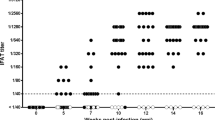Abstract
A double-blind randomized controlled trial was designed for a 6-month period to compare the efficacy of rifampin versus doxycycline during the subclinical phase of canine monocytic ehrlichiosis. Ten naturally Ehrlichia canis-infected dogs with anti-E. canis immunofluorescent antibodies ranging 1/80 to 1/1,280 were divided in two therapeutic groups. The first treatment group was scheduled by prescription of 10 mg/kg/d doxycycline for 28 days. The second group treated with rifampin 15 mg/kg every 12 h for 1 week. All treated dogs were examined periodically during the 6-month period posttreatment. Alterations in anti-E. canis immunofluorescent antibodies and clinicopathologic parameters were compared before and after treatment to evaluate the efficacy of therapeutic regimens. According to the initial antibody titer, no significant difference was observed in any of the five cases in each group. A substantial main effect of time on mean PCV, thrombocyte and erythrocyte count, and gradual resolution of hyperglobulinemia was significantly observed in all treated animals (p < 0.05), whereas no significant difference was noticed between studied protocols (p > 0.05). Similar clinicopathologic response was observed in both treated groups; thus, it was concluded that rifampin and doxycycline are equally effective for treatment of canine monocytic ehrlichiosis.






Similar content being viewed by others
References
Akhtardanesh B, Ghanbarpour R, Blourizadeh H (2009) Serological evidence of canine monocytic ehrlichiosis in Iran. Comp Clin Pathol. doi:10.1007/s00580-009-0889-5
Bartsch RC, Greene RT (1996) Post-therapy antibody titers in dogs with ehrlichiosis: follow-up study on 68 patients treated primarily with tetracycline and/or doxycycline. J Vet Intern Med 10:271–274
Breitschwerdt EB, Hegarty BC, Hancock SI (1998) Doxycycline hyclate treatment of experimental canine ehrlichiosis followed by challenge inoculation with two Ehrlichia canis strains. Antimicrob Agents Chemother 42:362–368
Dagnone AS, de Morais HS, Vidotto MC, Jojima FS, Vidotto O (2003) Ehrlichiosis in anemic, thrombocytopenic, or tick-infested dogs from a hospital population in South Brazil. Vet Parasitol 117:285–290
Dantas-Torres F (2008) The brown dog tick, Rhipicephalus sanguineus (Latreille, 1806) (Acari: Ixodidae): from taxonomy to control. Vet Parasitol 152:173–185
Eddlestone SM, Neer TM, Gaunt SD, Corstvet R, Gill A, Hosgood G, Hegarty B, Breitschwerdt EB (2006) Failure of imidocarb dipropionate to clear experimentally induced Ehrlichia canis infection in dogs. J Vet Intern Med 20:840–844
Harrus S, Aroch I, Lavy E, Bark H (1997a) Clinical manifestations of infectious canine cyclic thrombocytopenia. Vet Rec 141:247–250
Harrus S, Kass PH, Klement E, Waner T (1997b) Canine monocytic ehrlichiosis: a retrospective study of 100 cases, and an epidemiological investigation of prognostic indicators for the disease. Vet Rec 141:360–363
Harrus S, Waner T, Aizenberg I, Bark H (1998) Therapeutic effect of doxycycline in experimental subclinical canine monocytic ehrlichiosis: evaluation of a 6-week course. J Clin Microbiol 36:2140–2142
Hegarty BC, de Paiva Diniz PP, Bradley JM, Lorentzen L, Breitschwerdt E (2009) Clinical relevance of annual screening using a commercial enzyme-linked immunosorbent assay (SNAP 3Dx) for canine ehrlichiosis. J Am Anim Hosp Assoc 45:118–124
Iqbal Z, Rikihisa Y (1994) Reisolation of Ehrlichia canis from blood and tissues of dogs after doxycycline treatment. J Clin Microbiol 32:1644-1649
Mienkoth JH, Clinkenbeard KD (2006) Normal hematology of the dog. In: Schalm's veterinary hematology, 5th edn. Blackwell publishing, pp.1057-1063.
Neer TM, Harrus SH (2006) Canine monocytotropic ehrlichiosis and neorickettsiosis. In: Greene CE (ed) Infectious disease of the dog and cat, 3rd edn. Saunders Company, Philadelphia, pp 203–224
Neer TM, Breitschwerd EB, Greene RT, Lappin MR (2002) Consensus statement on ehrlichial disease of small animals from the infectious disease study group of the ACVIM. American College of Veterinary Internal Medicine. J Vet Intern Med 16:309–315
Neer TM, Eddlestone SM, Gaunt SD, Corstvet RE (1999) Efficacy of enrofloxacin for the treatment of experimentally induced Ehrlichia canis infection. J Vet Intern Med 13:501–504
Perille AL, Matus RE (1991) Canine ehrlichiosis in six dogs with persistently increased antibody titers. J Vet Intern Med 5:195–198
Schaefer JJ, Kahn J, Needham GR, Rikihisa Y, Ewing SA, Stich RW (2008) Antibiotic clearance of Ehrlichia canis from dogs infected by intravenous inoculation of carrier blood. Ann N Y Acad Sci 1149:263–269
Schaefer JJ, Needham GR, Bremer WG, Rikihisa Y, Ewing SA, Stich RW (2007) Tick acquisition of Ehrlichia canis from dogs treated with doxycycline hyclate. Antimicrob Agents Chemother 51:3394–3396
Scorpio DG, Wachtman LM, Tunin RS, Barat NC, Garyu JW, Dumler JS (2008) Retrospective clinical and molecular analysis of conditioned laboratory dogs (Canis familiaris) with serologic reactions to Ehrlichia canis, Borrelia burgdorferi, and Rickettsia rickettsii. J Am Assoc Lab Anim Sci 47:23–28
Shipov A, Klement E, Reuveni-Tager L, Waner T, Harrus S (2008) Prognostic indicators for canine monocytic ehrlichiosis. Vet Parasitol 153:131–138
Tvedten H (2004) Reference values. In: Willard MD, Tvedten H (eds) Small animal clinical diagnosis by laboratory methods, 4th edn. Elsevier, New York, pp 417–419
Acknowledgment
The authors are grateful to the research council of Shahid Bahonar University for financial support. They are in debt to Miss Montaseripour and Miss Adib for their great help and the many veterinary students who supplied them blood samples during the research period.
Conflict of interest
None of the authors of this paper has a financial or personal relationship with other people or organizations that could inappropriately influence the content of the paper.
Author information
Authors and Affiliations
Corresponding author
Rights and permissions
About this article
Cite this article
Akhtardanesh, B., Ghanbarpour, R. & Sharifi, H. Comparative study of doxycycline and rifampin therapeutic effects in subclinical phase of canine monocytic ehrlichiosis. Comp Clin Pathol 20, 461–465 (2011). https://doi.org/10.1007/s00580-010-1019-0
Received:
Accepted:
Published:
Issue Date:
DOI: https://doi.org/10.1007/s00580-010-1019-0



